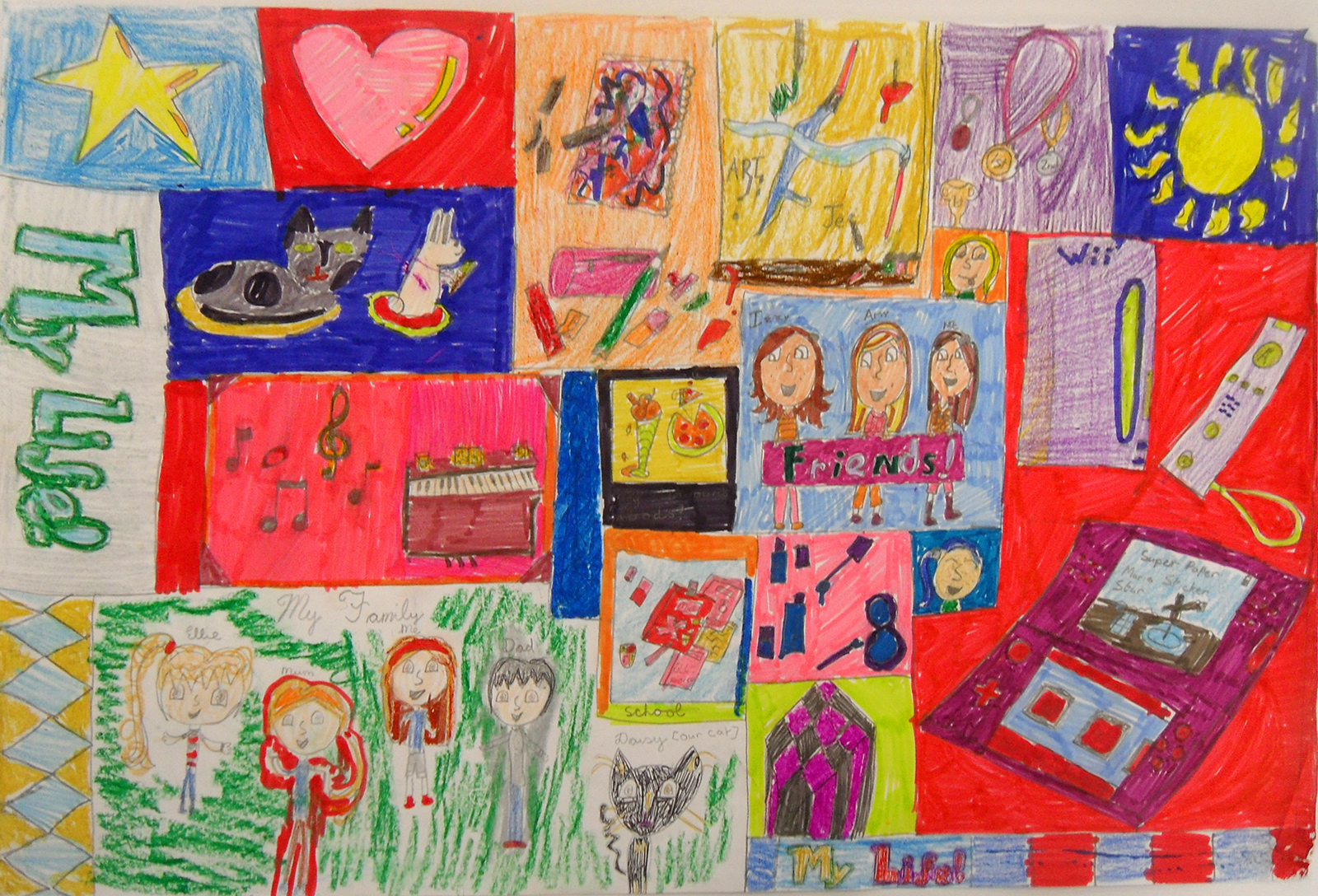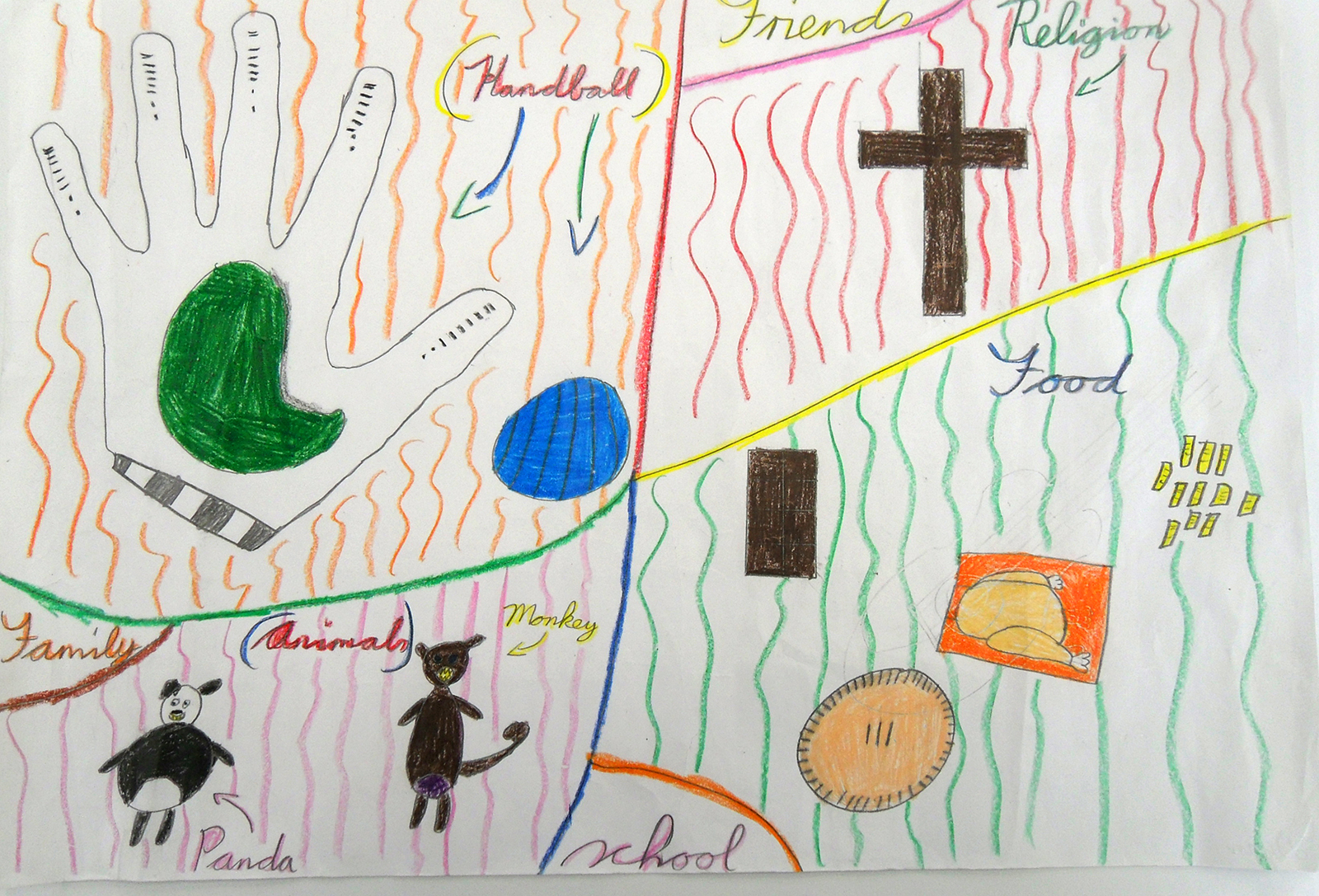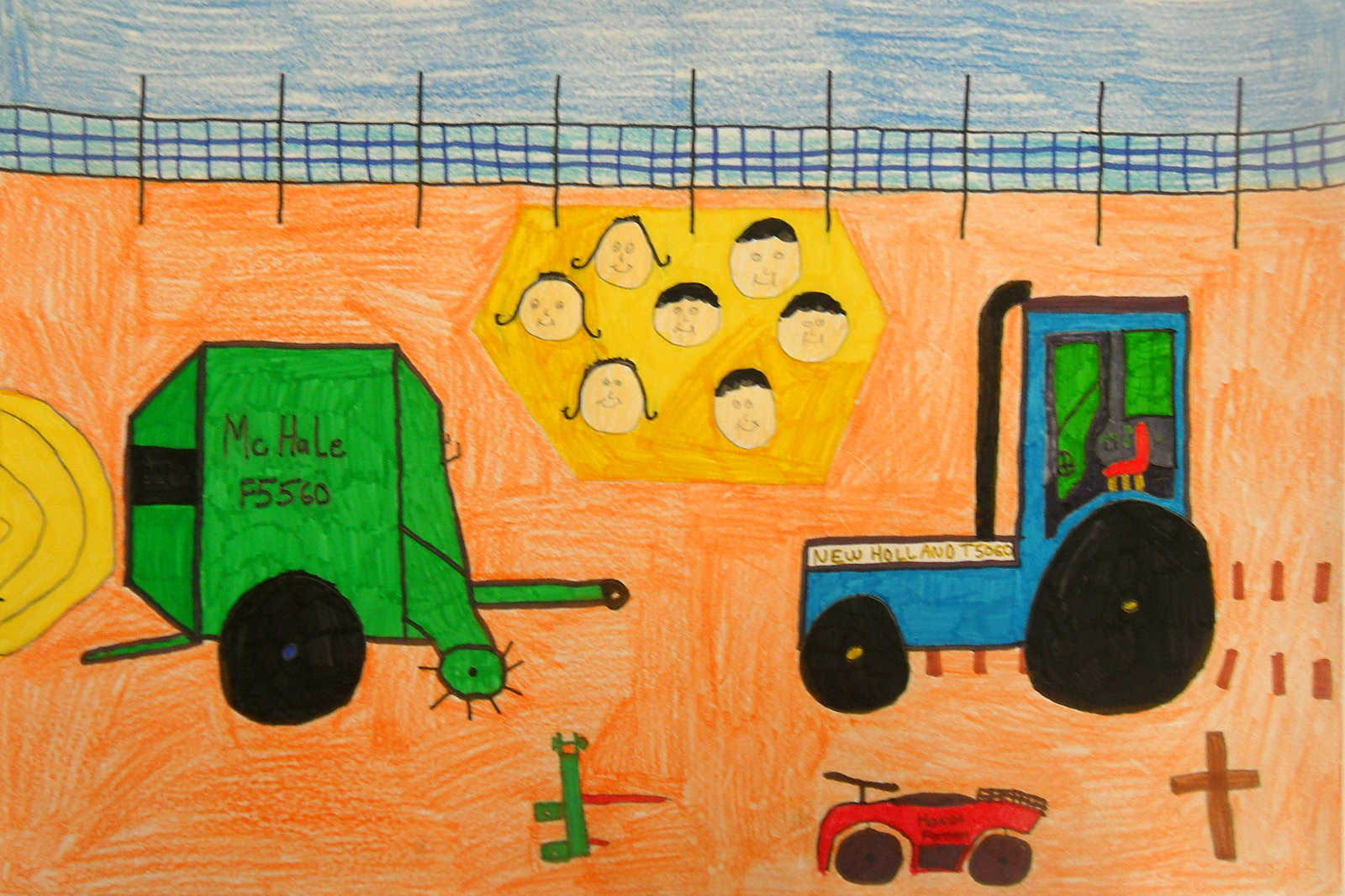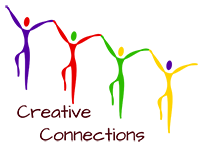Irish Lesson Plan
Scheme of Work: Exploring Individual and Collective Identities
Recommended Age Group: 9-12 years
Timescale: 7 lessons (1 hour per lesson)
Country: Ireland
Name of School: The Don’s National School Ballaghaderreen Co Roscommon
Conceptual Framework
Themes
- Mapping Place,
- Being European,
- Childscapes.
The project school that trialled these lessons for Creative Connections is Don’s National school, which is situated in a rural environment. The children are surrounded by nature and have a huge affinity with their immediate surroundings. Their local environment is a constant reference in which to explore personal identity. The theme of mapping place and the children’s reflections on living in a rural community influenced both the art process and the class discussions over the duration of the project. This theme was identified as a meaningful way in which to explore individual and collective identities and enabled the children to be proud of their own heritage and uniqueness.
Key Words
- Individual and Collective Identity,
- National,
- European,
- Stereotypes,
- Citizenship,
- Rural Environment,
- Belonging/Family,
- Similarities and Differences – Rural V’s Urban.
Learning Objectives
The pupils will be able to:
- Use photography as a means to explore and present concepts of identity.
- Create a series of observational drawings and mono-prints, based on found objects within the pupil’s environment, through the exploration of line, shape, texture and pattern based on the theme of ‘Childscapes’.
- Create drawings to explore individual and collective identities.
- Examine the work of contemporary artists through ‘a look and respond’ session to interrogate the concept of European and National identity.
- Explore texture and pattern in the environment through a series of rubbings.
- Explore a variety of printmaking techniques through mono-printing.
- Construct an ‘identity envelope’ though the exploration of texture and paper construction.
Citizenship
Pupils will be able to:
- Explore concepts of National and European Identity.
- Identify differences and similarities that exist within a community of people.
- Explore and describe how the environment influences pupil’s identity.
- Identify the similarities and differences between pupil’s lives and their European peers.
- Investigate what being part of the European Union (EU) means to all its members.
Resources and Preparation
Training Materials: Power-Point Presentations located on Creative Connections website
Title: Looking and Responding: CC artists bank - Approaches to exploring images http://creativeconnexions.eu/teachers/files/2013/04/Looking-and-Responding-to-CC-Artist-Bank.pdf
Title: Beginning the conversations – Getting to know your European Friends http://creativeconnexions.eu/teachers/files/2013/02/Beginning-the-conversation-CC.pdf
Art Image Bank on C.C. Website http://creativeconnexions.eu/art/
Art Materials
- Paper,
- Pencils,
- Card – White and coloured,
- Colouring Pencils,
- Oil Pastels,
- Scissors,
- Glue,
- Camera,
- Photographs,
- Photocopier,
- Tracing paper,
- Rubbers/ Erasers,
- Printing Inks,
- Printing Rollers,
- Envelope Template,
- Printed text on tracing paper,
- Acetate
Instructions for Activities
Lesson 1: Exploration of our individual and collective identity
Introduce the concepts of individual and collective identities by developing discussions among pupils through open-questioning.
For example:
- Where do we feel that we belong?
- What do you think we are like?
- What sort of things do we like?
Other topics for discussion might include:
- An exploration of what it means to belong to our family and neighbourhood
- Favourite foods
- Colours
- T.V programmes
- People we admire, etc.
Ask pupils to consider their school identity:
- Favourite games
- Subjects
- Books
- Activities
- Uniform
- School crest
- Parish identity
- Club identity etc.
For example:
- What does it mean to be a citizen/supporter of your local area?
- What makes us the same/ different from children living in other parts of the nation?
Pupils can be encouraged to research traditions, customs, religions, festivals etc.
Collect the pupil’s responses and create a class list or mind map.
Ask pupils to look and respond to a selection of images from the artwork database with the discussions they have had in mind.
Among recommended images for this activity are:
Micheal de Brito;
- ‘The Gathering’
- ‘Reunion’
- ‘Family Table’
- ‘Dinner Guests’
http://creativeconnexions.eu/art/2013/01/michael-de-brito-reunion/
Lesson 2: Exploration of the self
Pupils should be encouraged to bring in objects, clothing etc. from home. The objects should represent their identities and can be used as stimulus material in activities that follow. Begin by asking the pupils to explain what they have brought in and why, as a whole class or in small groups.
Each pupil should aim to complete both of the following activities during the session:
Activity 1
Pupils make individual drawings based on their items using large sheets of paper and charcoal, chalk on black paper and/or colouring pencils.
Activity 2
Pupils photograph their items and upload these to the computer. They might wish to edit their images using editing software, such as Photoshop, or an online site such as Pixlr. These photographs can be printed out and re-assembled and arranged at a later date when pupils have explored the concept of their own identity further.
Complete the session with a discussion of the activities and encourage pupils to show what it means to belong to their local community and beyond.
Lesson 3: Know Your Europe
This lesson will develop pupils’ perceptions and understanding of Europe. Ask pupils to explore their current knowledge of E.U. countries and how many of us, or our families, have been to Europe on holidays or to live.
Create mind maps documenting what they notice: language, food, weather, clothes, celebrations and traditions etc. Discuss the difference between what it is like to go on holiday to a country or to live in a country. Discuss what they understand about E.U and non-E.U countries.


What makes your own country and other E.U. countries the same, and what are the differences between these and non-E.U. Countries?
Use David Cerny’s Entropa from the Creative Connections artwork database and training materials - Approaches to exploring images – Looking and Responding: CC artists bank to ask pupils to ‘Look and Respond’ to the findings from the previous discussions.
http://creativeconnexions.eu/art/2013/01/david-cerny-entropa/
Lesson 4: My Coat of Arms
Pupils participate in a small group discussions and research for images on traditional symbols and signs, for example heraldic signs and exploration of Coats of Arms. Pupils can create their own crest or symbol. These can be made on a piece of paper ready-cut into a crest shape for each child to represent what it means to be “Me” in their national context.
Activity 1
Pupils participate in a small group discussion and research for images on traditional symbols and signs, for example, they might look at heraldic signs or Coats of Arms. They make sketches and designs to work out their ideas before transferring these to the creat shaped paper.
Activity 2
Use maps of your local area and ask pupils to trace an outline of the shape. Fill this shape with illustrations of what people think it is like to be a member of your national or local community.
Review the crest/country shapes that pupils have created for each child to represent what it means to be “Me” as a whole class. Continue with discussion on what the pupils have drawn and how/what images they could use to draw or photograph to show what it really means to belong to a community. Ask pupils to evaluate their own work in the light of these discussions and change or add anything to their own work that they want to.
Open a discussion on what it means to be a European citizen. Encourage the pupils to explore what it is really like to be Finnish, Spanish etc. How do they think they are alike or different?
Using the PowerPoint resource Approaches to exploring images – Looking and Responding in the CC artists bank, ASK pupils to explore the work of David Cerny and his images of national stereotypes such as ‘Entropa’ - David Cerny (Czech Republic). Ask pupils to respond to this by making drawings/representations of different countries using some visual art medium of their choice. They might, for example, choose to explore flags of European countries by drawing or illustrating these and arranging them artistically.
Lesson 5: European Identification
This lesson is a continuation of Lesson 4 and builds upon the children’s insights and reflections in previous learning. Use this session to further explore concepts of being European through the work of the following artists on the CC image bank
- Family Gathering - Michael De Brito (Portugal)
- The Butterfly Girl - Berenika Ovcackova (Czech Republic)
- Until The Third And Fourth Generation - Heli Kurunsaari (Finland)
This can be done by discussion, or by asking pupils to respond visually through drawing or collage.
Lesson 6: Mapping Place

In this lesson you can move the discussion on to investigate the children’s surrounding landscape and identity through the introduction and exploration of the following artists on the CC image Bank:
Alice Maher’s Limb: http://creativeconnexions.eu/art/2013/01/alice-maher-limb/
John Ahearn’s Francis Street Boys http://creativeconnexions.eu/art/2013/01/john-ahearn-francis-street-boys/
Use training materials; Approaches to exploring images – Looking and Responding: CC artists bank (contains a bank of questions on Maher and Ahearn)
Other work by Alice Maher can be explored via her website; http://www.alicemaher.com
Ask pupils to respond to the images and ask them to link their ideas and thoughts to exploring the concept of how their environment influences their identity.
Possible questions you might pose are:
- Do you think Alice Maher’s Limb is unique? If so why?
- Does the image give us any idea where Alice grew up? How?
- Why are artists influenced by where they grew up?
- How would you be influenced by where you are living?
- How might that be shown in your artwork?
Lesson 7: Childscapes
Time frame - 1 ½ hours
Printmaking workshop
Aim; To create a series of observational drawings and mono-prints, based on found objects within the pupils’ environment, through the exploration of line, shape, texture and pattern based on the theme of ‘childscapes.’
Learning Outcomes
- Create a series of observational drawings of found objects through the exploration of line and shape.
- Explore texture and pattern in the environment through a series of rubbings.
- Explore a variety of printmaking techniques through mono printing.
- To construct a simple envelope though the exploration of texture and paper construction
Artist: Alice Maher
Source Material: The following stimulus is needed for the workshop:
1. Prior to the workshop ask pupils to answer the following questions:
- What do you feel is unique about the place you live in?
- Think about the landscape that surrounds you. If you close your eyes what pictures come to mind?
Pupils’ reflections can be written or typed and printed out on A4 pages and used to create ‘identity envelopes’ (see Activity 3 below).
2. Each child should take a photograph that captures what they think is unique about their landscape
3. Ask each pupil to bring in natural/found objects from their environment. They should choose objects that represent their place, whether these are everyday ordinary things that we take for granted or special objects. Have a variety of natural and manmade objects to hand in case not everyone brings something.
Management of Learning environment
Set up 4 tables – children will be organised into 4 groups and rotate between tables every 15 minutes. The tables will include the following art stations-
- 2 print-making table
- 1 Rubbings table
- 1 envelope construction table
Activities
Station 1
- Teacher Task: Demonstrate simple rubbing exercise with chubby crayons and use of inks to wash over crayon markings.
- Pupils Task: Make a series of rubbings from textured objects and use ink wash.
Station 2
- Teacher Task: Demonstrate mono-printing process using found object as subject matter to draw from.
- Pupils Task: Create mono-prints of observational studies of found object using an array of textured papers/tracing paper.
Station 3
- Teacher Task: Demonstrate how to construct an envelope using simple template.
- Pupils Task: Pupils to create envelopes from textured rubbing's or tracing paper with image and text (their reflections) on them.
Activity for whole class
At the end of the session give pupils of overview of the activities and ask them to reflect on their tasks.
- Evaluation of pupils’ work.
- Post up artwork to CC site and begin blogging process on Creative Connections site
Blogging
Pupils should be encouraged to upload images to the Creative Connections website and engage in dialogue with partner schools through blogging.
Objectives
- Exploring concepts of identity, belonging and mapping place through a multimedia visual approach
- Upload images to Creative Connections website
- Blogging with European counterparts
- Read and post comments on Artwork created by their blogging partners
Learning outcomes and assessment opportunities
- Questioning during class discussions
- Children’s written reflections on Artist work, their own work and experience of project
- Visual outcomes – Photographs, Drawing, Prints
- Surveys to reflect and evaluate their experience
- Children’s blogging and interaction with European peers online


